Parents of Ayotzinapa, 8 years of pain without justice 5:09
(CNN) --
Parents of the 43 students who disappeared in Ayotzinapa nearly eight years ago marched through the streets of Mexico City last week, in their first protest since the release of a shocking Mexican government report blaming the military and the police of the country of what happened.
Relatives, holding signs with photos of their children and calling for justice, told CNN they hoped the report would ultimately lead to criminal punishment for those responsible.
The new calls for justice to be done come after the Government's Commission for Truth and Access to Justice presented a devastating report on August 18 concluding that the disappeared students were victims of a "state crime". ".
Finding out what really happened to the 43 students was one of President Andrés Manuel López Obrador's 100 campaign promises during the July 2018 presidential election. The renewed investigation under his presidency linked federal, state, and local authorities—many of them unidentified—with "the disappearance and execution of the students."
He also claims that an order had been given to carry out the 2014 atrocity, although he refrains from naming who gave the order.
On September 26, 2014, university students headed to Mexico City to mark the anniversary of the 1968 Tlatelolco massacre, in which government forces killed 300 student protesters.
advertising
Arrest warrants following the Ayotzinapa report
While traveling through the southwestern city of Iguala, the Ayotzinapa students were intercepted by local police and federal military forces.
Exactly what happened next is still unknown, as most of the missing students were never found.
But later buses riddled with bullets were seen on city streets, windows shattered and bloodied.
Survivors of the original group of 100 said their buses were also stopped by armed police and soldiers who suddenly opened fire.
No one has been convicted in connection with the students' disappearance.
However, the new report has led to more than 80 arrest warrants being issued against members of the Army, the Police and members of the Mexican cartels.
Former attorney of Mexico will face criminal proceedings for Ayotzinapa 3:03
Former Mexican Attorney General Jesús Murillo Karam — the same one who previously led the government's investigation into the disappearance — is among those detained on charges that include enforced disappearance and torture.
Murillo Karam's defense argued that the crimes attributed to his client were not substantiated, since they were based on statements and press conferences given at the time by the previous prosecutor in the case and were "taken out of context."
Still, some parents of the disappeared refuse to believe that their children are dead, citing a lack of concrete evidence.
The agents "don't say anything," said Don Margarito Guerrero.
"We have to keep fighting then. We are not going to withdraw until we know something."
His 21-year-old son, Jhosivani Guerrero, along with two of his nephews, are among the 43 missing.
Guerrero says that the son, his youngest, worked hard selling water to help earn money and enjoyed studying.
Margarito Guerrero has not stopped seeking justice.
On August 26, the Undersecretary for Human Rights, Population and Migration of the Mexican Ministry of the Interior, Alejandro Encinas, revealed that six of the 43 Mexican students were "allegedly kept alive for several days in what they call 'La Bodega Vieja' and from there they were handed over to a (military) colonel".
Encinas said that according to the report, the Army officer gave the order to execute the captive students in the warehouse.
"It is presumed that six of the students remained alive for four days after the events and that they were killed and disappeared," it added.
They reveal where 6 Ayotzinapa students were held 0:53
But parents like Maximino Hernández Cruz, who clings to fast-fading memories of his son Carlos (19), want justice.
After eight years, his emotions have died down.
Her tears have almost dried up, leaving in their wake an almost permanent fatigue in her eyes.
"We want those responsible to be punished (...). They have to pay for what they did to our children," Hernández Cruz said.
"We are suffering. We are dead inside."
a sacred place
Before traveling to Mexico City for their monthly protests, the parents of the 43 disappeared first meet in the small farming town of Ayotzinapa.
They meet at the school where their children lived, worked and studied.
Photos and murals, mementos of "los 43", surround the sprawling rural campus.
"It reminds you that they were also part of Ayotzinapa," a current student, who only wanted to be identified as César, told us when sharing how the disappearance of the 43 has impacted classmates and teachers.
"They were our companions, and although they are the ones who disappeared, we know that it can happen to any of us."
Under the shelter of a thin metal roof and exposed walls, on what was once a basketball court, are 43 empty classroom chairs with photos of the disappeared.
Cesar calls it a "sacred space," which current Ayotzinapa students respect by not playing sports or playing loud music nearby.
The Rural Normal School of Ayotzinapa is one of the so-called "normal schools" in Mexico in which education is provided to rural and indigenous communities, mostly impoverished.
It offers college-age students opportunities ranging from learning academic knowledge to job-oriented skills, such as agriculture.
"As farmers we don't have many resources," said Maximino Hernández Cruz.
He explained that back then he had been grateful that his son was able to receive a free education along with room and board.
"We didn't have enough money to send him to a private school. That's why he attended the Escuela Normal Rural. They gave the students shelter, food, everything they wanted," Hernández Cruz said.
The school is also known for inspiring activism, encouraging students to question the status quo and hold those in power to account.
"We really need to raise our voices so that people listen to us, listen to our demands, our needs, because as students if we don't raise our voices, they don't really pay attention to us," said one of the students, who asked to be identified by the pseudonym " Alexander Mora".
The 20-year-old described the importance of the school reaching underserved communities like those in the Mexican state of Guerrero.
"We have to encourage people of all backgrounds to be represented so that they can help change society for a better future," Mora said.
Infiltrated by "the corruption and violence of the cartels"
The trip to Mexico City from Ayotzinapa, on winding and mountainous roads through the state of Guerrero, takes about five hours.
The lush vegetation hides what the locals describe as a place infiltrated by the corruption and violence of the cartels.
The US Department of State warns US citizens not to travel to the state due to crime and kidnapping.
"Armed groups operate independently of the government in many areas of Guerrero," he says.
"Members of these groups frequently maintain roadblocks and may use violence against travellers."
The memory of the Ayotzinapa students and the search for answers and justice continue in Mexico.
The loved ones of the 43 disappeared, now dedicated to a life of activism, are undeterred as they drive across the state as part of their regular journey to the capital, where they collectively march for justice.
Every month they board the buses to Mexico City to protest, following a route eerily similar to their children's unfinished trip in 2014.
"If we let him go, there is no justice," said Margarito Guerrero.
"It will continue the same again and again (...) That is what we fight for, for justice."
They cannot travel far in Guerrero without seeing graffiti and photos referencing "the 43" or the more than 100,000 people estimated to have disappeared in Mexico since the 1960s.
His is just a sample of the suffering that is spreading throughout the country.
In Mexico, families of the disappeared have formed more than 130 "search groups" to investigate disappearances on their own, according to Human Rights Watch.
And according to a 2022 report from the International Committee of the Red Cross, 40,000 relatives of disappeared people in Mexico over the years have participated in training sessions to search for their loved ones.
Still, there are moments when Guerrero's pain is clouded by a hopeful memory.
"I remember he would always show up somewhere with his sweater slung over his shoulder," Guerrero says with a worn smile.
"She Sometimes he tells me that she is going to come, but when?"











/cloudfront-eu-central-1.images.arcpublishing.com/prisa/KMEYMJKESBAZBE4MRBAM4TGHIQ.jpg)



